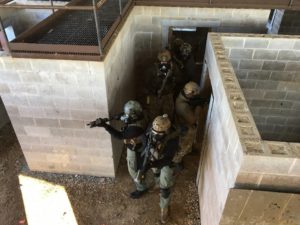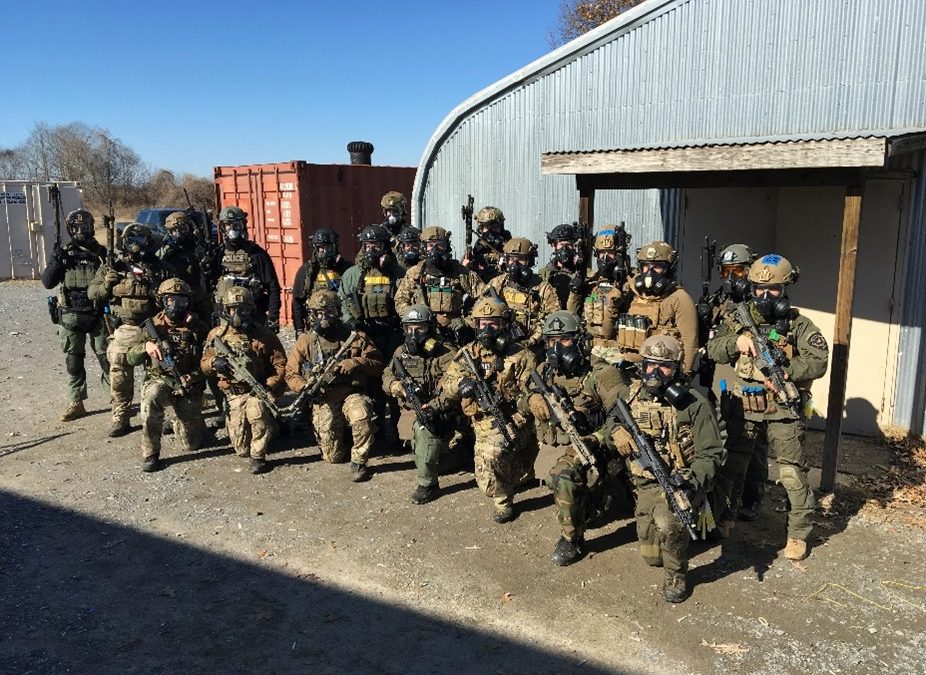Since 2014, the Prince George’s County Police Department (PGPD) prioritized the development and implementation of a comprehensive training program for the department’s Special Operations Division (SOD) personnel. PGPD identified several tactical capabilities requiring specialized training, including sniping, breaching, close-quarters battle (CQB), and incident command. Through the Maryland-National Capital Region Emergency Response System (MDERS), PGPD partnered with the Direct-Action Resource Center, a leading training facility in Little Rock, AR. DARC specializes in tactical, technical and strategic planning, developmental training, evaluation, and implementation for the military, law enforcement, public agencies, and private enterprises.
 DARC offers curriculum designed to build in complexity as students progress into more advanced tactics. DARC requires all students to complete two pre-requisite courses prior to enrolling in more advanced offerings. These pre-requisites are identified and summarized below.
DARC offers curriculum designed to build in complexity as students progress into more advanced tactics. DARC requires all students to complete two pre-requisite courses prior to enrolling in more advanced offerings. These pre-requisites are identified and summarized below.
- LECTC-1: Teaches tactical personnel the basics of enemy tactics, chemical, biological, radiological, nuclear, and explosive (CBRNE) operations.
- LECTC-2: Further expands upon the principles learned in LECTC-1 while incorporating the basics of live fire breaching tactics and hostage rescue best practices.
 After completing the LECTC-1 and LECTC-2 prerequisites, students may enroll in specialized response areas, such as advanced operational breaching, advanced sniper integration, and tactical night vision instruction. These courses provide operators with the knowledge and tools required to lead a breaching team, integrate a sniper and observer team in tactical operations, deploy during large venue counter-terrorism operations, and conduct operations using night-vision capabilities. The specific courses attended by PGPD since 2014 are identified and summarized below.
After completing the LECTC-1 and LECTC-2 prerequisites, students may enroll in specialized response areas, such as advanced operational breaching, advanced sniper integration, and tactical night vision instruction. These courses provide operators with the knowledge and tools required to lead a breaching team, integrate a sniper and observer team in tactical operations, deploy during large venue counter-terrorism operations, and conduct operations using night-vision capabilities. The specific courses attended by PGPD since 2014 are identified and summarized below.
- Level One Breacher Course (L1BC): Educates operators on the basics of safe, practical, and effective explosive breaching techniques for tactical operations.
- Advanced Explosive Breaching and Program Supervisors Course: Focuses on explosive breaching and the development and sustainment of a breaching program for managing or supervisory positions within an organization.
- Advanced Sniper Integration Course (ASIC): Instructs sniper and observer teams on the skills and tactics necessary to provide support for tactical operations in complex environments or large venues under a variety of conditions, ranges, visibility, and target types.
- Tactical Night Vision Instructor Course: Instructs law enforcement training officers on the deployment, integration, limitations, and considerations of night vision technology to bring back to their local departments and create in-house training programs for other law enforcement personnel.
- Tactical Supervisor/Managers Course: Trains SWAT supervisors and managers to prepare SWAT teams for operations, document their activities, conduct short- and long-term planning, including training, sustainment, outfitting, and acquisition of specialized skills.
As a result of the long-standing partnership, PGPD and DARC collaborated to develop a custom-tailored curriculum that incorporates tactical emergency casualty care (TECC) in CQB situations, under both live and simulated fire. This course, entitled Close Quarters Battle/TECC, integrates emergency medicine, explosive and ballistic breaching, live-fire training, and force-on-force training across a variety of high threat scenarios including active shooters, high risk warrants, barricades, hostage rescue, and complex coordinated terrorist attacks. To date, 31 members of PGPD SOD participated in this specialty offering.
Through DARC, over 147 PGPD officers trained on tactical capabilities, mater advanced skillsets, and gain operational experience to respond to high-stress austere environments. PGPD continues to pursue opportunities to provide more advanced and specialized training for its personnel so that they may better serve the residents of Prince George’s County.


